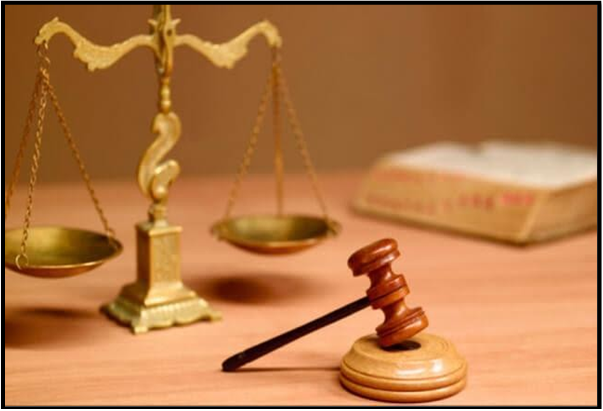THE LAW IS HUMAN, NOT DIVINE
Relevance:
- GS 1: Indian Society – Role of women and women’s organisations, population issues, poverty and development challenges, urbanisation, its problems, and
- GS 2: Responsibilities and functions of the Union and the States, challenges and issues related to the federal structure, separation of powers, dispute resolution mechanisms, and
- GS 2: The role of the judiciary in upholding constitutional values, judicial activism, and balancing religious practices with constitutional morality.
- GS 4: Ethics, Integrity, and Aptitude – Ethical issues in law and justice, and the importance of ethical governance in balancing religious practices with constitutional mandates.
source:asighnmentpoint.com
Why in the News?
Recently, Chief Justice of India, D Y Chandrachud, emphasised that courts should not be equated with temples and judges should not be revered as deities. This statement has sparked renewed discussions on the interface between law and religion in India.
Human vs. Divine Law:
- Innate Religious Inclinations: Indians hold deep religious beliefs. Nevertheless, the Constitution of India, while revered by some, maintains a distinct separation between religious matters and the judicial domain.
- Prime Minister’s Position: Prime Minister Narendra Modi has frequently asserted that his sole sacred text is the Constitution of
Religion in Indian Politics:
● Interweaving of Religion and Politics: Indian politics often intertwines with religious symbols and narratives. Examples include Ram Lalla’s 1989 petition and the Namami Gange project.
● Electoral Advantage: Political leaders frequently leverage religious sentiments to garner electoral support, evident in the BJP’s use of Lord Ram’s imagery and the Congress’s references to Hindu deities during campaigns.
- Historical Campaigns: Various political parties have employed references to Hindu mythology and religion to resonate with the religious sentiments of
Judiciary and Religious Symbols:
- Presence of Religious Symbols in Courts: Despite the secular foundations of the Indian Constitution, religious symbols such as the statue of Manu in the Rajasthan High Court remain
- Colonial Legacy: Addressing judges as “My Lord,” a practice steeped in religious connotations, reflects colonial influences that blend judicial authority with divine
Constitutional Morality vs. Religious Morality:
- Interweaving of Religion and Politics: Indian politics often intertwines with religious symbols and Examples include Ram Lalla’s 1989 petition and the Namami Gange project.
- Electoral Advantage: Political leaders frequently leverage religious sentiments to garner electoral support, evident in the BJP’s use of Lord Ram’s imagery
- Supreme Court’s Approach: The Supreme Court’s rulings on issues like triple talaq, Sabarimala, and the Ayodhya dispute demonstrate efforts to harmonise constitutional values with religious
- Triple Talaq: In 2017, the Supreme Court deemed the practice of instant triple talaq (talaq-e-bidat) unconstitutional, prioritising gender justice and equality over religious customs.
- Sabarimala: The 2018 verdict permitting women of all ages to enter the Sabarimala temple upheld constitutional rights to equality and non-discrimination against traditional religious
- Ayodhya Verdict: In 2019, the Supreme Court ruled in favor of constructing a temple at the disputed Babri Masjid site in Ayodhya, balancing historical religious sentiments with legal
- Navigating Delicate Boundaries: The judiciary faces the delicate task of upholding the Constitution while respecting religious
Key Judiciary Cases Involving Religion- Law Conflicts:
- Triple Talaq Case: The Supreme Court’s landmark decision in Shayara Bano Union of India (2017) outlawed instant triple talaq, safeguarding individual rights against regressive religious practices.
- Sabarimala Temple Case: The 2018 judgement challenging traditional menstrual taboos by allowing women of all ages into the Sabarimala temple in Kerala upheld the constitutional rights of equality and non-discrimination.
- Ayodhya Verdict: The 2019 judgement resolving the Babri Masjid-Ram Janmabhoomi dispute allocated land for a Ram temple, reflecting the intricate interplay of legal, historical, and religious considerations.
- Shani Shingnapur Case: In 2016, the Bombay High Court affirmed gender equality in religious spaces by permitting women to enter the inner sanctum of the Shani Shingnapur
- Haji Ali Dargah Case: The Bombay High Court’s 2016 decision to allow women entry into the inner sanctum of the Haji Ali Dargah in Mumbai overturned a discriminatory ban.
Role of the Judiciary and Secularism:
- Commitment to Secularism: The judiciary’s mandate is to uphold the Constitution and maintain a secular stance while interpreting
- Rising Religious References: Concerns arise over the increasing use of religious references in judicial decisions potentially undermining the nation’s secular stance while interpreting laws.
- Constitutional Morality:
“Constitutional morality” necessitates that laws and policies strictly adhere to the Constitution, devoid of religious influence. For instance, the Uttarakhand High Court’s recognition of legal personhood for the Ganga and Yamuna rivers.
Examples and Historical Contexts:
- Ram Lalla’s Petition: The 1989 plea for ownership of the Babri mosque site and the subsequent 2019 Supreme Court verdict in favour of constructing a
- Legal Personhood of Rivers: The Uttarakhand High Court’s decision to grant legal personhood to the Ganga and Yamuna
- Symbolism in Judiciary: Terms like “My Lord” in courtrooms carrying religious
Secularism in Practice:
- Equal Treatment: The Indian Constitution envisages a state where all religions receive equal However, religious sentiments often influence the political and legal landscapes.
- Upholding Rights: The judiciary must uphold secular principles while ensuring religious practices do not infringe upon constitutional
Judicial Independence and Accountability:
- Freedom from External Pressures: The judiciary must remain independent from religious and political pressures to deliver fair and impartial judgments.
- Balancing Act: Judicial accountability involves ensuring judges’ personal religious beliefs do not influence their legal decisions, crucial for maintaining judicial integrity and upholding constitutional values.
Conclusion:
- Man-Made Law: Law is a construct of humanity and should not be confused with divine Courts must prioritise constitutional values and dispense justice impartially, free from religious biases.
- Secular and Impartial Judiciary: Safeguarding the judiciary’s secular and impartial character is essential for upholding the rule of law and safeguarding the rights of all citizens.
Mains Practice Question:
Examine the judiciary’s role in preserving the secular essence of the Indian Constitution. How can courts reconcile constitutional morality with religious beliefs? (250 words)
Source: The Indian Express




